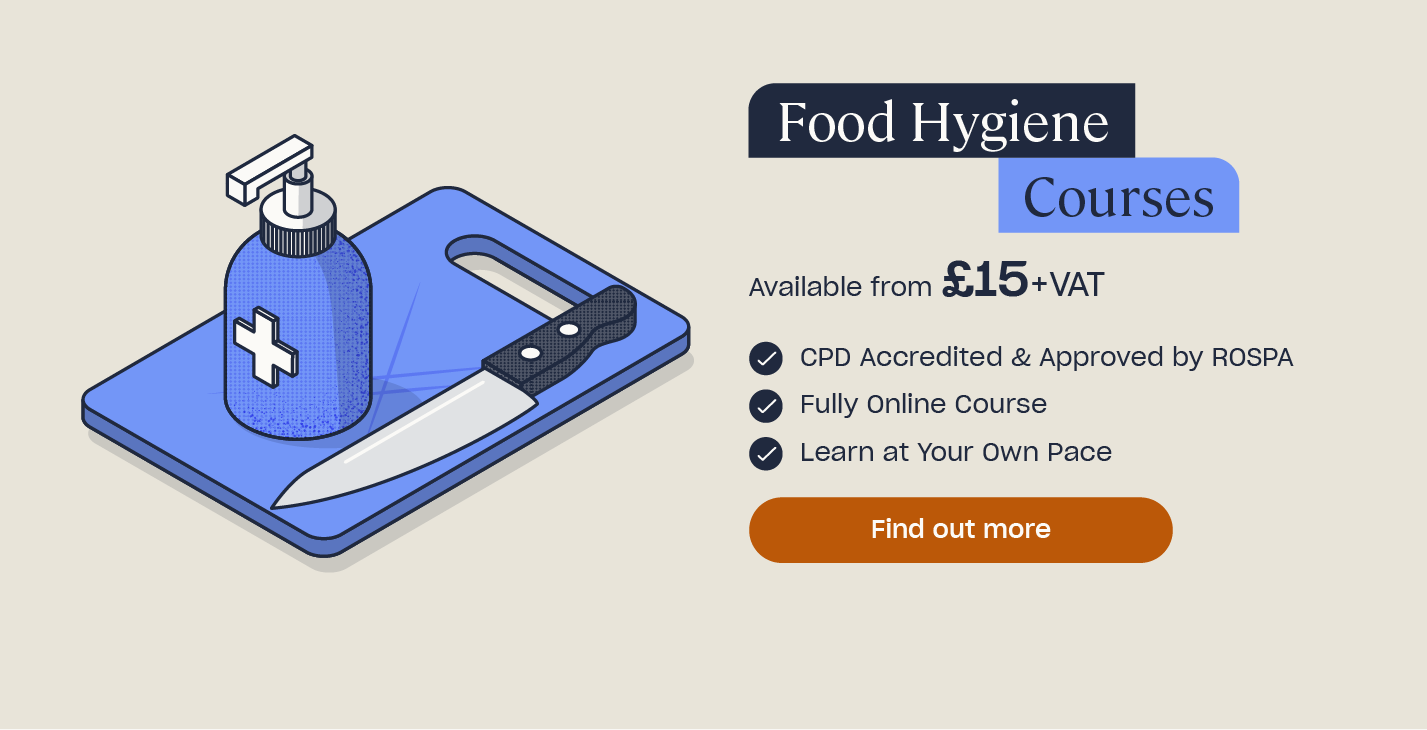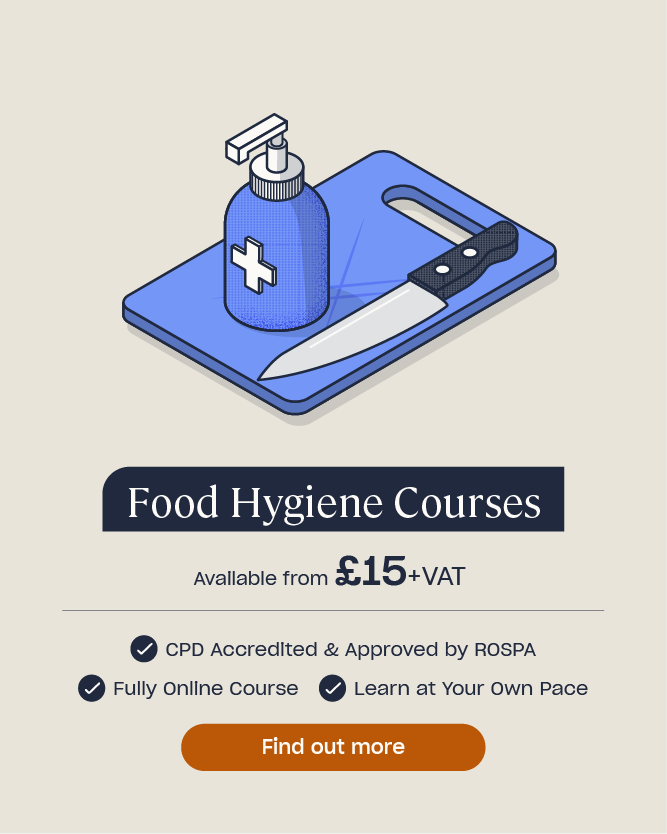What is Salmonella and How Do I Prevent It?
Whether you work in hospitality, or simply enjoy cooking at home, it’s essential that you have a thorough understanding of food safety in order to keep the people that consume your food safe from foodborne diseases. It’s estimated that there are 2.4 million cases of food poisoning every year in the UK, and while most people recover within a few days, in severe cases, it can be life-threatening. One of the most common types of food poisoning is Salmonella.
In this article, we will outline what Salmonella is and the symptoms that often come with it. We will also discuss the most common causes of salmonella, and ways in which you can prevent it.
What is Salmonella?
Salmonella are a group of bacteria that cause food poisoning by affecting the intestinal tract. There are approximately 2,400 types of Salmonella bacteria, but the most common are Salmonella enteritidis and Salmonella typhimurium. A Salmonella infection is also known as salmonellosis.
It is estimated that 10,000 people in the UK are infected with Salmonella each year. Occasionally, there are outbreaks that can be traced back to a specific food source. For example, the outbreak in April 2022 regarding certain Kinder products made by Ferrero. However, these outbreaks are relatively rare.
The Salmonella bacteria live in the intestines of many farm animals and during rearing, slaughter and processing, can be transferred into food products. They can also be found in pests – such as rats, mice and flies – and domestic animals.
The bacteria are commonly spread through inadequate cooking or bacterial cross-contamination, and are most often found in:
- Undercooked poultry.
- Raw meat.
- Raw eggs.
- Unpasteurised milk.

Unlike other foodborne diseases, food that is contaminated with Salmonella may not look, smell or taste out of the ordinary. Therefore, it’s crucial to understand how Salmonella is caused, in order to prevent it.
For more information on the different kinds of food poisoning, check out our article, here.
What are the Symptoms of Salmonella?
Symptoms of salmonella typically show between 6 hours and 6 days of eating the contaminated food. The symptoms can vary, however, possible signs and symptoms of salmonella infection include:
- Diarrhoea.
- Fever.
- Stomach cramps or nausea.
- Vomiting.
- Headaches.
- Chills.
The symptoms often last between 1 and 7 days, and most people don’t need to seek medical attention as the illness clears up on its own. However, Salmonella – like other forms of food poisoning – can be especially dangerous to people who have weakened immune systems, such as young children and the elderly. Salmonella can also result in dehydration, if the fluids lost aren’t replaced.
Some of the strains of Salmonella, such as Salmonella typhimurium, can result in typhoid fever. This is a serious bacterial infection that can cause severe complications, and in certain cases, be fatal.

What are the Causes of Salmonella?
As we’ve established, Salmonella bacteria live in the intestines of many farm animals and birds. Other foods such as fruit, vegetables and shellfish, can become contaminated through contact with animal and human faeces – for example, sewage in water or manure that is used for soil fertility. People can become infected when they consume contaminated food.
There is a wide range of foods that carry Salmonella bacteria, however, the most common food sources include:
- Poultry, raw meat and seafood. Poultry and raw meat may become contaminated during the butchering process, whereas seafood can pose a risk if the water it is harvested from has been contaminated.
- Raw or undercooked eggs. Some chickens produce eggs that contain salmonella before the shell has formed to protect the egg from disease. Raw eggs are also used as ingredients in food products such as mayonnaise. The British Lion safety scheme now produces 90% of the UK’s eggs, and has drastically reduced the presence of Salmonella in their eggs. They’ve managed this through careful monitoring, and a code that ensures the hens are vaccinated against Salmonella. You can find their code of practice here.
- Fruits and vegetables. These can become contaminated through contact with animal or human faeces, and through being washed during processing with contaminated water. They can also become contaminated in a kitchen environment if juices from contaminated raw meat or poultry drip onto ready-to-eat foods, such as a prepared salad.
- Unpasteurised dairy products. Pasteurisation is a process that kills harmful bacteria, such as Salmonella. Dairy products that haven’t been through this process – for example, unpasteurised or ‘raw’ milk – may be contaminated with the bacteria.

For more information on the foods that are more likely to cause a food-related illness, take a look at our article: What are High-Risk Foods and How Can I Use Them Safely?
Salmonella can also be caused by handling or storing food improperly. For example, if a food handler doesn’t thoroughly wash their hands after going to the toilet, or if raw and cooked foods have been stored together, resulting in cross-contamination.
Need a Course?
All food handlers must have an understanding of the principles of food safety, so as to protect the food they serve from contamination. Our range of Food Safety courses will give you knowledge of your legal responsibilities when handling food and are available for catering, retail and manufacturing industries.
How to Prevent Salmonella
Having high standards of food hygiene and safety is essential in order to prevent Salmonella, along with other types of food poisoning. Remember, food that has been contaminated with Salmonella may not look, smell or taste out of the ordinary, and so you cannot simply rely on these senses to tell you when a food may be dangerous.
Instead, there are steps you can take to reduce the risk of Salmonella being present in your food. Ensuring you follow these steps in the kitchen is the safest way to safeguard against becoming ill from Salmonella contamination.
This includes:
- Washing your hands thoroughly. This should be done before handling food – especially raw food, after visiting the toilet, after handling any waste or cleaning products and after touching your face, mouth or hair. For more information, check out our article and free downloadable poster: The 7 Steps of Handwashing – Free Poster.
- Avoiding cross-contamination. Cross-contamination is the process whereby harmful bacteria, such as Salmonella, spreads onto other foods, surfaces, hands or equipment. For more information, check out our article: Avoiding Cross-Contamination in the Kitchen.
- Ensuring foods – especially poultry and raw meats – are cooked thoroughly. Bacteria multiply rapidly between 5 °C and 63 °C (known as the “danger zone”) and the optimum temperature is 37 °C (room temperature). As such, one of the most important steps to prevent food poisoning is to ensure food is sufficiently cooked. A core cooking temperature of 70 °C for two minutes or 75 °C for thirty seconds will normally destroy bacteria and make the food safe to eat. For more information, take a look at our article: What is the Temperature Danger Zone?
- Washing fruits and vegetables before eating them. This ensures that any bacteria present are washed away and therefore reduces the chance of contracting an illness such as Salmonella. For more information, read our article: Washing Food: How and Why Should We Do It?
- Using colour-coded chopping boards. One of the most common ways to prevent cross-contamination, and therefore reduce the risk of food safety hazards, is to use colour-coded chopping boards. For example, you can ensure that foods such as raw meat, are prepared separately from ready to eat foods, such as salad vegetables. For more information, check out our article: What Colour Chopping Board Do I Need?
We hope you’ve found this article on Salmonella and how to prevent it helpful. If you have any further questions, or wish to find out more information on the topics covered in this article, please don’t hesitate to get in touch with us at High Speed Training!
Further Resources
- What Foods Are Safe to Eat Raw?
- Safe Temperatures for Food Storage: A Free Guide to Cooling and Chilling Times
- Food Safety Myths and Facts
- A Short Guide to Acrylamide in Food
- Answering Your FAQs About Egg Safety
- Online Food Hygiene Training Courses







